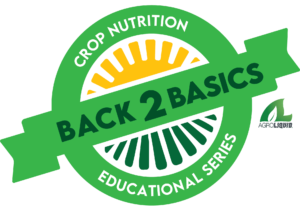Back 2 Basics
A Video Series from AgroLiquid
Nitrogen

Nitrogen is one of the primary nutrients essential for crop growth and yield. It plays a major role in protein development and chlorophyll production, helping plants convert sunlight into energy. Nitrogen is highly mobile in the soil and can easily leach, especially in sandy soils. Because of this, managing application timing and placement is critical to ensure crops get enough nitrogen throughout their growth.
Soil CEC (cation exchange capacity) helps determine how much nitrogen the soil can hold; a simple rule is to multiply CEC by 10 to estimate the pounds of nitrogen that can be applied at once. Organic matter also releases nitrogen naturally—typically 20 to 40 pounds per 1% organic matter.
Nitrogen deficiency shows as yellowing (chlorosis) starting on older leaves and progressing upward, which is opposite of potassium deficiency patterns. Nitrogen interacts with other nutrients, like magnesium and sulfur, affecting how efficiently plants can use them. It is also commonly used as a carrier for foliar applications of other nutrients.
All crops require nitrogen, but legumes can fix their own and usually need less added fertilizer. Because nitrogen availability can change throughout the season, ongoing soil testing and careful management are key to maintaining healthy crops and maximizing yield potential.


